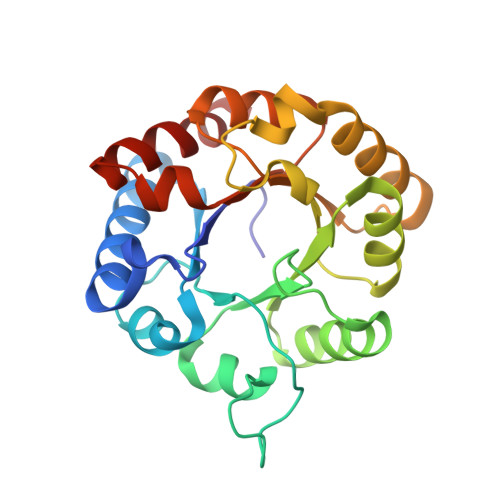Structure and Function of a Regulated Archaeal Triosephosphate Isomerase Adapted to High Temperature
Walden, H., Taylor, G., Lorentzen, E., Pohl, E., Lilie, H., Schramm, A., Knura, T., Stubbe, K., Tjaden, B., Hensel, R.(2004) J Mol Biol 342: 861
- PubMed: 15342242
- DOI: https://doi.org/10.1016/j.jmb.2004.07.067
- Primary Citation of Related Structures:
1W0M - PubMed Abstract:
Triosephophate isomerase (TIM) is a dimeric enzyme in eucarya, bacteria and mesophilic archaea. In hyperthermophilic archaea, however, TIM exists as a tetramer composed of monomers that are about 10% shorter than other eucaryal and bacterial TIM monomers. We report here the crystal structure of TIM from Thermoproteus tenax, a hyperthermophilic archaeon that has an optimum growth temperature of 86 degrees C. The structure was determined from both a hexagonal and an orthorhombic crystal form to resolutions of 2.5A and 2.3A, and refined to R-factors of 19.7% and 21.5%, respectively. In both crystal forms, T.tenax TIM exists as a tetramer of the familiar (betaalpha)(8)-barrel. In solution, however, and unlike other hyperthermophilic TIMs, the T.tenax enzyme exhibits an equilibrium between inactive dimers and active tetramers, which is shifted to the tetramer state through a specific interaction with glycerol-1-phosphate dehydrogenase of T.tenax. This observation is interpreted in physiological terms as a need to reduce the build-up of thermolabile metabolic intermediates that would be susceptible to destruction by heat. A detailed structural comparison with TIMs from organisms with growth optima ranging from 15 degrees C to 100 degrees C emphasizes the importance in hyperthermophilic proteins of the specific location of ionic interactions for thermal stability rather than their numbers, and shows a clear correlation between the reduction of heat-labile, surface-exposed Asn and Gln residues with thermoadaptation. The comparison confirms the increase in charged surface-exposed residues at the expense of polar residues.
Organizational Affiliation:
Centre for Biomolecular Sciences, University of St Andrews, St Andrews, Fife KY16 9ST, Scotland, UK.















